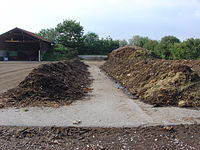
Photo from wikipedia
This study was conducted to examine the effects of controlled addition of liquid (LM) to solid (SM) manure compost using a volume-model technique on the co-composting of SM and LM,… Click to show full abstract
This study was conducted to examine the effects of controlled addition of liquid (LM) to solid (SM) manure compost using a volume-model technique on the co-composting of SM and LM, and further to investigate the major effects of bulking material sizes and LM types on the co-composting process and final compost characteristics. Results indicated that this volume-model technique played a critical role in reducing leachate generation and improving the overall efficiency of the co-composting process. Specifically, the developed model enhanced the evaporation rates of windrows during the co-composting process. For improved final compost properties, small bulking materials and swine-effluent-based LM were found to be more efficient for organic matter degradation, LM consumption, hazardous metals immobilization, and essential nutrients retention than large bulking materials and biogas-based LM. Thus, process parameter optimizations represent major research options for successful co-composting applications for the future.
Journal Title: Bioresource technology
Year Published: 2019
Link to full text (if available)
Share on Social Media: Sign Up to like & get
recommendations!